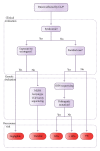Genetics and management of the patient with orofacial cleft
- PMID: 23213504
- PMCID: PMC3503281
- DOI: 10.1155/2012/782821
Genetics and management of the patient with orofacial cleft
Abstract
Cleft lip or palate (CL/P) is a common facial defect present in 1 : 700 live births and results in substantial burden to patients. There are more than 500 CL/P syndromes described, the causes of which may be single-gene mutations, chromosomopathies, and exposure to teratogens. Part of the most prevalent syndromic CL/P has known etiology. Nonsyndromic CL/P, on the other hand, is a complex disorder, whose etiology is still poorly understood. Recent genome-wide association studies have contributed to the elucidation of the genetic causes, by raising reproducible susceptibility genetic variants; their etiopathogenic roles, however, are difficult to predict, as in the case of the chromosomal region 8q24, the most corroborated locus predisposing to nonsyndromic CL/P. Knowing the genetic causes of CL/P will directly impact the genetic counseling, by estimating precise recurrence risks, and the patient management, since the patient, followup may be partially influenced by their genetic background. This paper focuses on the genetic causes of important syndromic CL/P forms (van der Woude syndrome, 22q11 deletion syndrome, and Robin sequence-associated syndromes) and depicts the recent findings in nonsyndromic CL/P research, addressing issues in the conduct of the geneticist.
Figures



Similar articles
-
[Epidemiology of orofacial clefts (1995-2006) in France (Congenital Malformations of Alsace Registry)].Arch Pediatr. 2012 Oct;19(10):1021-9. doi: 10.1016/j.arcped.2012.07.002. Epub 2012 Aug 24. Arch Pediatr. 2012. PMID: 22925539 French.
-
Genetics of syndromic and nonsyndromic cleft lip and palate.J Craniofac Surg. 2011 Sep;22(5):1722-6. doi: 10.1097/SCS.0b013e31822e5e4d. J Craniofac Surg. 2011. PMID: 21959420 Review.
-
Orofacial clefting: update on the role of genetics.B-ENT. 2006;2 Suppl 4:20-4. B-ENT. 2006. PMID: 17366841
-
Sequencing the GRHL3 Coding Region Reveals Rare Truncating Mutations and a Common Susceptibility Variant for Nonsyndromic Cleft Palate.Am J Hum Genet. 2016 Apr 7;98(4):755-62. doi: 10.1016/j.ajhg.2016.02.013. Epub 2016 Mar 24. Am J Hum Genet. 2016. PMID: 27018475 Free PMC article.
-
Toward an orofacial gene regulatory network.Dev Dyn. 2016 Mar;245(3):220-32. doi: 10.1002/dvdy.24341. Epub 2015 Sep 17. Dev Dyn. 2016. PMID: 26332872 Free PMC article. Review.
Cited by
-
Epidemiology, Etiology, and Treatment of Isolated Cleft Palate.Front Physiol. 2016 Mar 1;7:67. doi: 10.3389/fphys.2016.00067. eCollection 2016. Front Physiol. 2016. PMID: 26973535 Free PMC article. Review.
-
Assessing agreement between preclinical magnetic resonance imaging and histology: An evaluation of their image qualities and quantitative results.PLoS One. 2017 Jun 30;12(6):e0179249. doi: 10.1371/journal.pone.0179249. eCollection 2017. PLoS One. 2017. PMID: 28666026 Free PMC article.
-
Need for orthognathic surgery in cleft patients from Northern Finland.Acta Odontol Scand. 2024 Apr 11;83:140-143. doi: 10.2340/aos.v83.40338. Acta Odontol Scand. 2024. PMID: 38605577 Free PMC article.
-
Differential methylation is associated with non-syndromic cleft lip and palate and contributes to penetrance effects.Sci Rep. 2017 May 26;7(1):2441. doi: 10.1038/s41598-017-02721-0. Sci Rep. 2017. PMID: 28550290 Free PMC article.
-
Impact of relaxing incisions on maxillofacial growth following Sommerlad-Furlow modified technique in patients with isolated cleft palate: a preliminary comparative study.BMC Surg. 2023 Nov 23;23(1):358. doi: 10.1186/s12893-023-02247-5. BMC Surg. 2023. PMID: 37996863 Free PMC article.
References
-
- Mossey P, Castilla E. Global registry and database on craniofacial anomalies. Proceedings of the World Health Organization Registry Meeting on Craniofacial Anomalies; 2001; Bauru, Brazil.
-
- Mossey PA, Little J, Munger RG, Dixon MJ, Shaw WC. Cleft lip and palate. The Lancet. 2009;374(9703):1773–1785. - PubMed
-
- Bender PL. Genetics of cleft lip and palate. Journal of Pediatric Nursing. 2000;15(4):242–249. - PubMed
-
- Kerrigan JJ, Mansell JP, Sengupta A, Brown N, Sandy JR. Palatogenesis and potential mechanisms for clefting. Journal of the Royal College of Surgeons of Edinburgh. 2000;45(6):351–358. - PubMed
LinkOut - more resources
Full Text Sources
Miscellaneous
